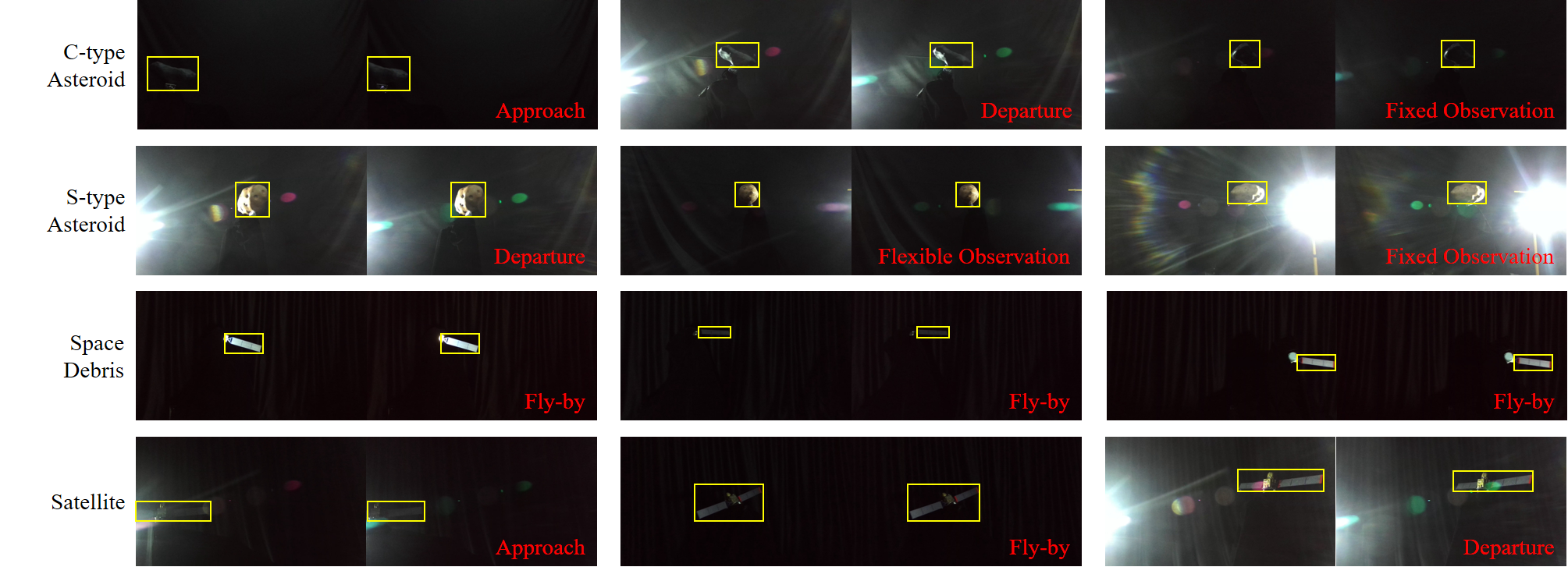Space non-cooperative object visual tracking (SNCOVT) with monocular or binocular camera is one of the most significant tasks for on-orbit services. To verify the availability of those generic trackers in aerospace domain, we present a moderate and simulated space non-cooperative object visual tracking dataset, which contains 60 binocular video sequences with manual annotations, 54742 frames in total. Meanwhile, a new evaluation protocol that is more appropriate to the practical scenario and some novel metrics are adopted into our SNCOVT evaluation toolkit.
See more details about SNCOVT dataset in 2D vision-based tracking algorithm for general space non-cooperative objects.
If you use this code or our dataset please cite:
@article{ZHOU2021193,
title = {2D vision-based tracking algorithm for general space non-cooperative objects},
journal = {Acta Astronautica},
volume = {188},
pages = {193-202},
year = {2021},
issn = {0094-5765},
doi = {https://doi.org/10.1016/j.actaastro.2021.07.023},
author = {Dong Zhou and Guanghui Sun and Jialin Song and Weiran Yao}
}
Note that: Training set of SNCOVT included 20 binocular video sequences is totally public, while test set is still preserved.
- Baidu Netdisk: | train set | test set without annos | (code: 1111)
- Google Drive: | train set | test set without annos |
Once download our SNCOVT dataset, please make dataset on your PC following this form:
Root_dir
|
|--train
| |
| |--sequence id {:04d}
| |--img
| | |--left
| | | |--{:06d}.jpg
| | | ...
| | |--right
| | |--{:06d}.jpg
| | ...
| |--annotations.csv
| |--check_file.txt
|--test
| |
| |--sequence id {:04d}
| |--img
| | |--left
| | | |--{:06d}.jpg
| | | ...
| | |--right
| | |--{:06d}.jpg
| | ...
| |-- check_file.txt
And then, you'd better to run following commands to check the integrity of dataset with multi-threads:
$: git clone https://github.com/Dongzhou-1996/SNCOVT.git
$: cd SNCVOT
$: python
>>> from SNCOVT_Dataset import SNCOVT
>>> sncovt = SNCOVT('{dataset_dir}', subset='train')
>>> sncovt.integrity(thread_nums=4)
if return True, the dataset is integral.
Furhtermore, you can see all the binocular image with SNCOVT.dataset_display(), for example:
>>> from SNCOVT_Dataset import SNCOVT
>>> sncovt = SNCOVT('{dataset_dir}', subset='train')
>>> sncovt.dataset_display()
During dataset displaying, you can press ESC key to stop and n to visualize next sequence.
The normal method provided by us to access data is as follows:
sncovt = SNCOVT(args.dataset_dir, subset='train')
for s, sequence in enumerate(sncovt):
for i, (left_img_path, left_roi, right_img_path, right_roi, truncation) in enumerate(sequence):
print('=> Sequence {}, Frame: {}/{}'.format(sequence.name, i+1, sequence.__len__()))
In this repository, we have provided plenty of monocular trackers like SiamRPN, SiamFC, ECO, BACF, MCCTH, SAMF, CSRDCF, STRCF, MKCFup, KCF, DAT, DCF, CSRDCF, CSK, MOSSE, Staple, which are also motioned in our paper.
The summary lists of requirement for above trackers:
- pytorch >= 1.4
- numpy
- matplotlib
- opencv-python
- got10k
- cupy-cuda110 or other version 101, 100, relies on the cuda version on your PC
- mxnet-cu110 or other version, the same as cupy
- numba
- scipy
- h5py
- colorama
- Cython
- tqdm
- Pillow
- pandas
You can also install all the requirements with following command:
pip install -r requirements.txt
Most of CF trackers are derived from PyTrackers. If you want to use these CF based trackers, please implement the install instructions as follows:
$: cd {repository path}
$: cd trackers/lib/eco/features
$: python setup.py build_ext --inplace
The other trackers to be adopted in our monocular or binocular evaluation algorithm, should wrapper two methods tracker.init() & tracker.update().
Pre-trained SiamRPN models:
- Baidu Netdisk (code: 1111)
- Google Drive
To evaluate diverse monocular tracking method mentioned above, we create a new class MonoTracker to re-wrap them. It mainly consits of three method MonoTracker.__init()__, MonoTracker.init(), and MonoTracker.update(). You can simply evaluate those trackers on our SNCOVT dataset as follows:
$: cd {repository path}
$: python
>>> from mono_evaluation import ExperimentMonoTracker, MonoTracker
>>> mono_tracker = MonoTracker('DAT')
>>> mono_evaluation = ExperimentMonoTracker('{dataset_root}', subset='train', use_dataset=True, repetition=3)
>>> mono_evaluation.normal_run(mono_tracker, save_video=True, overwrite_result=True)
>>> mono_evaluation.report([mono_tracker.name], plot_curves=True, overwrite=True)
There is few binocular tracker, we therefore utilize a new class PseudoBinoTracker to re-wrap classic monocular tracker for binocular tracking. So you can simpy evaluate those pseudo binocular tracker on our SNCOVT dataset as follows:
$: cd {repository path}
$: python
>>> from bino_evaluation import ExperimentBinoTracker, BinoTracker
>>> bino_tracker = PseudoBinoTracker('DAT')
>>> bino_evaluation = ExperimentBinoTracker('{dataset_root}', subset='train', use_dataset=True, repetition=3)
>>> bino_evaluation.normal_run(mono_tracker, save_video=True, overwrite_result=True)
>>> bino_evaluation.report([bino_tracker.name], plot_curves=True, overwrite=True)




